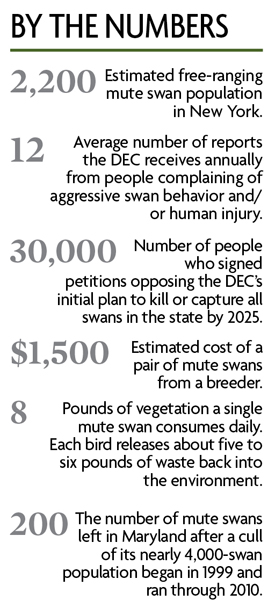Lines being drawn as DEC takes aim at majestic swan

WHAT’S THE PROBLEM?
Aggression toward humans and native animal species, the depletion of submerged vegetation in aquatic ecosystems and degraded water quality due to droppings are among the negative impacts of mute swan populations, environmental experts say. Those concerns have prompted the state Department of Environmental Conservation to develop a wildlife management plan aimed at greatly reducing populations.
See also: Sides meet in Albany to discuss mute swan’s fate
The DEC first floated a plan to eradicate all swans in New York, but the idea was met with great resistance and officials were forced to go back to the drawing board. People value the down-feathered bird for its beauty and inherent ability to complete a scenic vista.
 HISTORY
HISTORY
The mute swan is an invasive species originally brought to North America from Eurasia in the late 1800s. By 1910, some of the swans were released or managed to escape captivity, establishing a free-ranging population of about 500 birds between Long Island, the lower Hudson Valley and an area near Lake Ontario. The population has since grown, peaking at more than 2,800 birds in 2002 before dropping to the current number of 2,200 statewide. Of those, about 1,000 live on Long Island.
THAT TIME OF YEAR
Mute swans tend to be most aggressive during the nesting period, which begins in late March to early April.
On average, the birds lay six eggs total, at a rate of one egg per day. Eggs hatch about 35 days after the last egg is laid. The average hatch date for New York swans is around June 1. Just three offspring typically survive to adulthood and become ready to fly at about 4 to 5 months old. If the initial nest fails, re-nesting may occur.
FIGHT OR FLIGHT
As their name indicates, mute swans aren’t known for being vocal. If threatened, however, they may grunt, snort, or hiss as a warning to humans and other animals. Weighing in at an average of 20-25 pounds, adult birds can use their nearly 7-foot wingspan and long necks to peck and rough up predators. Humans are advised to keep alert and steer clear of swans protecting their nests or young.
Aggression among swans often occurs for the same reason. You’ll know the fight is on when males raise their wings and fluff their feathers — an action known as “busking” — and begin twirling in place, a ritual that appears more like a dance than a fight.
It’s important to note that raising wings and fluffing feathers is also part of the mating ritual.
*Data compiled from Cornell University and New York State Department of Environmental Conservation reports

REPORTS: Swan drowned man in Chicago
Police in the Chicago area blamed a mute swan for drowning a kayaker in 2012.
According to the Chicago Tribune, Anthony Hensley, 37, of Villa Park, Ill., worked for a Canada goose management company called Knox Swan and Dog, which uses mute swans and Border collie dogs to keep geese — and their droppings — off condominium properties and golf courses.
On the morning of April 14, Mr. Hensley, a married father of two young girls, was kayaking in a Des Plaines pond when he paddled over to check on some of the company’s birds, which he regularly cared for. One of the swans reportedly swam at him, causing him to fall out of the kayak and into the water, according to the report. He was not wearing a life jacket. Witnesses at the scene said the swan continued to swim after Mr. Hensley, lunging at him aggressively as he struggled to make it to shore.
Mr. Hensley then disappeared under the water of the 50-foot-deep pond, Cook County authorities said. Investigators believed Mr. Hensley got too close to the swan and/or the swan’s nesting area, prompting the attack. The man’s death was ruled an accidental drowning. Last week, the Tribune reported that his wife, Amy, is suing Knox Swan and Dog. The lawsuit claims the company “knew or should have known that mute swans are strongly territorial with a dangerous propensity to attack.”
[email protected] Follow @carriemiller01








